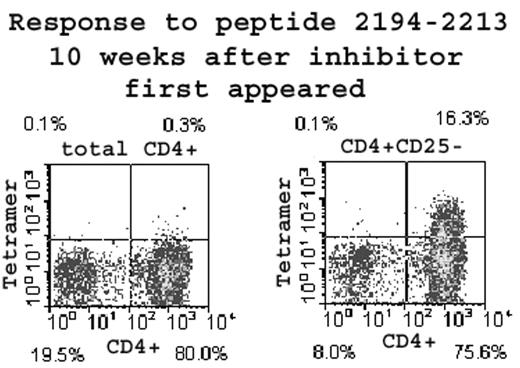Abstract
A mild hemophilia A subject with a missense mutation, A2201P, developed high titer neutralizing antibodies against infused factor VIII (FVIII) following post−operative FVIII administration. This missense mutation is in the C2 domain of FVIII. His baseline clotting activity fell from 10% to 3% of normal; FVIII infusions were discontinued, and his factor VIII clotting activity improved to its baseline within 2 mo. His inhibitor titer to FVIII declined over the ensuing year during which 12 samples were studied for T−cell epitopes, antibody titer, or both. His HLA haplotype was DR0101/DR1503, allowing use of fluorescent−labeled MHC Class II tetramers specific for DR0101. These were loaded with synthetic 20−mer peptides spanning the FVIII C2 domain to identify specific T cells responding to epitopes on FVIII by FACS. Proliferation assays were also carried out stimulating T cells with FVIII, the recombinant wild−type FVIII C2 domain, the C2 domain with mutation A2201P, and peptides. Tetramer staining and proliferation assays of total CD4+ and CD4+CD25− fractions indicated that CD4+CD25+ regulatory T cells modulated his immune response to FVIII between 10 and 19 weeks following the initial bleed. Peptides containing the wild type A2201, but not P2201, elicited strong T−cell responses. Markedly decreased staining of the total CD4 fractions compared to CD4+CD25− fractions in response to a peptide containing A2201 was observed between weeks 10 and 19 (see Figure showing staining at week 10). T−cell proliferation assays were carried out for cloned, expanded T cells that were selected using the tetramers. These T cell clones proliferated in response to FVIII, wild−type C2 protein, and peptides with the native A2201 sequence, whereas a peptide containing the mutation A2201P abrogated tetramer binding and proliferation. The T−cell epitope corresponded to a predicted MHC Class II binding motif for DR0101, underscoring the importance of studying T−cell responses within the context of each individual’s HLA haplotype. The epitope also overlapped a B−cell epitope identified by peptide mapping of the subject’s anti−FVIII C2 domain IgG fraction. Tetramer−guided T−cell epitope mapping provides greater sensitivity and specificity and markedly less ambiguous information than traditional mapping methods based on proliferation in response to peptides. FACS sorting of stained T cells allowed cloning of single T cells that retained the original specificity for the factor VIII peptides comprising this immunodominant T−cell epitope.
Response to peptide 2194-2213 10 weeks after inhibitor first appeared
Response to peptide 2194-2213 10 weeks after inhibitor first appeared
Disclosure: No relevant conflicts of interest to declare.
Author notes
Corresponding author


This feature is available to Subscribers Only
Sign In or Create an Account Close Modal